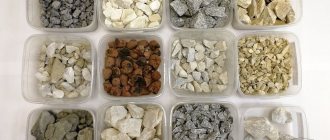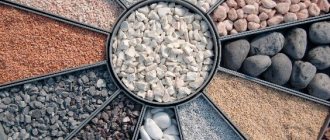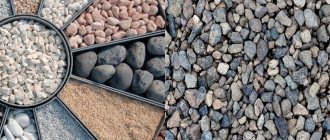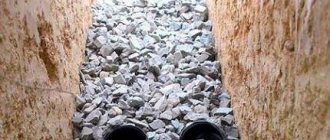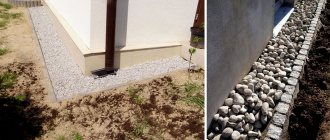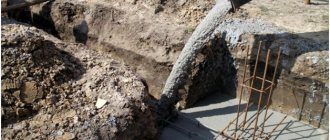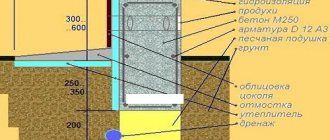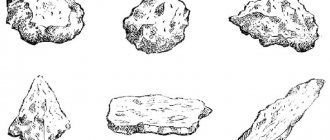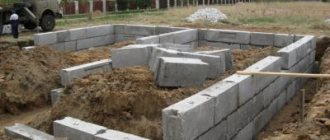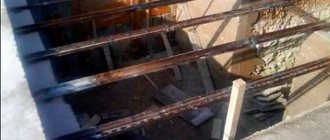Concrete is a popular building material that is used everywhere. When working with concrete, pay attention to its strength, density and other quality characteristics, which are important when constructing various buildings. To achieve these indicators, they adhere to the correct preparation of the concrete solution in compliance with the sequence of the technological process. A popular preparation technology is granite concrete, which allows the construction of buildings and structures of high strength and reliability.
Definition
Granite screening is a building material obtained during the production of crushed granite stone. The color of granite screenings is red or gray. Thanks to its positive qualities, granite for concrete is a sought-after material in the world of construction. After all, it is strong, dense, durable and easy to install.
There is one significant drawback in granite screenings - high cost. To make high-strength concrete, adhere to the proportions when preparing. The use of granite chips replaces sand, which affects the proportions of the solution.
Return to contents
Extraction of granite crushed stone
Granite crushed stone is mined by crushing granite.
The block is undermined, and the material is distributed into fractions in a special machine. This work is done by designated organizations with special equipment. Granite itself is a huge rock of solidified magma that has been pushed to the surface. The basis of this stone is quartz. Based on this, the color of the stone can be red, pink, gray, brown. USEFUL INFORMATION: concrete on granite crushed stone is the strongest with a heavy mass that reaches 2500 kg per 1 m3. A mixture of concrete on granite crushed stone is used in the construction of huge structures such as bridges, nuclear power plants, multi-storey buildings, offices, and cottages. The strength of this material is 1000-1500 kg/cm2, which means excellent characteristics and quality of concrete.
Features of the composition
Granite screening consists of:
- cement;
- sand;
- water;
- binder;
- strength filler, which is used as gravel, crushed stone, slag, expanded clay or pebbles.
To increase the strength and grade, facilitate the laying of the solution and prevent rapid hardening, special additives are used. Special additives are also used to provide concrete with frost protection during the cold season.
Return to contents
Advantages
When working with granite concrete, the following advantages are observed:
- granite chips have high strength, which consists of mica, spar and quartz;
- there is the possibility of “springing”, which allows you to perceive vibrations;
- withstands tension and compression that occurs due to expansion under high degrees of heat;
- the stone has high strength and resistance to coloring;
- the large mass of the stone allows it to be used in places where a reduction in the center of gravity is required;
- resistance to loads;
- average cost of stone and its easy transportation;
- ease of installation;
- the solution is easily compacted.
Return to contents
Areas of use
Granotsev is used:
- for the foundation of buildings and structures;
- for the construction of monolithic structures and load-bearing elements;
- for the construction of platforms, stairs, screeds.
To build the foundation, concrete mortar is used depending on the load. For the foundations of multi-story buildings, concrete mortar grade M300 is used. In places where the soil is not subject to crumbling, the foundation is filled with concrete mortar of any brand, including durable M400. Before building a foundation and choosing a mixture, you need to consult with an architect; his consultation will allow you to save money and purchase a mortar of the required brand and strength.
Return to contents
Is it possible to make concrete from crushed limestone?
Home / About Concrete / Is it possible to make concrete from crushed limestone
To make concrete products strong and durable, when mixing concrete, crushed stone is added, which is mined in limestone quarries. It is widely used in road construction. Popular in construction. Not many people know what crushed limestone for concrete is. Therefore, it is worth clarifying some informational nuances of this material.
Crushed limestone does not have high strength and water permeability, but is still indispensable in the production of reinforced concrete products and concrete blocks. Despite the fact that limestone is inferior in characteristics to granite crushed stone, it is used as a powder for road surfaces where light transport cargo is transported.
- Radioactive background.
- Frost resistance.
- Strength, durability.
- Ease of assembly on construction sites.
- Budget cost of crushed limestone.
Making concrete from crushed limestone
The main part of this material is calcium carbonate. Because it is from particles of living organisms and chemical precipitation that limestone is formed. It is mined underground from white layers by crushing. The fewer impurities the material has (quartz, clay), the better the quality. The size of the stones depends on the intensity of crushing with a special device. For decorative products, the smallest size is used - 0.5 mm, the largest - 200 mm is used to fill huge supporting walls and large volumes of concrete. Medium-sized crushed stone, approximately 10*20mm, is popular. This is used to build bridges, roads, airports, foundations, etc. Crushed stone must comply with state standards, only after that it can be sent to various works.
To make concrete, you need to mix water, cement, sand and crushed stone. But that's not all. An integral factor is the mobility of the resulting mass. To increase it, water is added, which leads to a deterioration in the quality of concrete. Limestone crushed stone has the grade M250, M300. The price depends on the type of indication, which is specified upon purchase.
Common products that are popular in the construction of houses are reinforced concrete objects, concrete slabs, and foundation blocks. Purchasing crushed limestone is not a problem; it is available in any quantity.
Only here we sell recycled crushed stone and limestone at really competitive prices! To buy, just dial the phone number +7 !
source
Crushed limestone is one of the cheapest types of material. However, each of its factions finds its application in construction. For example, fine crushed stone (5-20) is often used in road construction, building cladding and lime production. The middle fraction (20-40) is often used for backfilling, landscaping, and the production of medium-sized reinforced concrete structures. Crushed stone 40-70 is most often used in automobile and railway construction for laying cushions.
What size crushed limestone is needed for concrete? Fractions 5-20 and 20-40 are suitable. At the same time, the second option for the foundation is simply ideal, and therefore is the most common.
However, “ideal” is not quite the right word. Crushed limestone can be used to produce concrete, and if the material has good characteristics, the final product will be of fairly high quality. However, this approach has its pros and cons.
Of course, the main advantage is the price - especially compared to more expensive granite crushed stone. In terms of characteristics, crushed limestone is quite inferior to its older brother, which, however, does not prevent it from being used in the production of concrete.
To obtain a concrete structure of the best quality, indicators of strength, frost resistance, flakiness and the presence of impurities are important.
- Strength. Typically, crushed stone grade M400-M600 is used for concrete solutions. Such indicators are quite sufficient for the production of high-quality concrete, especially if the load on the structure is small or medium.
- Flakiness. Basically, this material belongs to class I-II, which according to GOST means “high-quality crushed stone”. The number of needle-like and lamellar grains is less than 15% of the total mass. This means that there will be no voids in the concrete that reduce the strength of the structure, and the cost of the solution will not be too high.
- Frost resistance. On average it is 50-200 cycles. For this type of crushed stone, sudden changes in temperature and large amounts of precipitation are not a problem. Therefore, frost resistance is one of the main advantages.
- Impurities. As a rule, the percentage of impurities is about 5-12%, so this characteristic does not affect the final strength.
Additional advantages of this material are impact resistance, low radioactivity and resistance to moisture.
The main disadvantage is not the highest strength. Crushed gravel has a strength of 800-1200 Pa, and granite - 1200-1400 Pa. However, this minus is also a plus. Due to its low resistance to mechanical stress, limestone crushed stone is easily compacted, which can significantly strengthen the structure. And the bulk density is very good for the same reason.
Thus, this type of crushed stone can serve as both an independent filler material for concrete and a cheaper analogue of the granite or gravel variety.
source
Concrete is the most common building material, the production of which will require:
Crushed stone ensures the strength and durability of the solution.
In construction, it is customary to separate mortars by grade, which are designated by the letter M and a number next to it. The higher the latter, the higher the cement content in the mixture, which means the higher its strength. A mortar made without crushed stone is called cement or sand concrete.
The limestone composition on crushed stone is made in the proportion cement: sand: crushed stone: water, equal to 1: 4: 2: 1.5.
Depending on the brand of cement, concrete, sand and gravel characteristics, the proportions may vary.
Table of compositions of limestone mortars.
Crushed stone can be calcareous or limestone (obtained from limestone), gravel (gravel is used for its production) and granite (respectively, from granite). Crushed limestone is the cheapest of all of the above, quite frost-resistant, but the least durable . Concrete on crushed limestone is available in grades M100-M300. This is a mortar with the lowest cement content, and therefore the least durable. Limestone crushed stone and mortar based on it are suitable, among other things, for laying strip foundations, floors and various non-critical structures, fences, staircases. Grades M100 are used for the construction of shallow foundations and foundation slabs, M150 - for pouring floors in rooms without exposure to an aggressive environment, M200 - for private construction, and M250 and M300 - for monolithic floors, beams, foundations in wetlands.
To prepare a more durable mortar (grade M350 and higher), crushed limestone is no longer used, since it is not suitable for the construction of structures with heavy loads. For this purpose, gravel and gravel concrete obtained from it are used, and for particularly durable structures, granite composition is used. Gravel is a sedimentary rock made from grains 5-70 mm in size, round in shape with a smooth surface. In crushed stone, the shape of the grains is angular and the surface is rough. Thanks to this, there is greater traction in crushed stone.
When cement hardens, it turns into stone, but the stone is not very strong, prone to deformation, with volumetric shrinkage of up to 2 mm. The value, of course, is small, but due to the impossibility of controlling the uniformity of shrinkage processes, these 2 mm cause internal stress and microcracks, which reduce the durability and strength of the cement stone. Therefore, in order to avoid the dangers described above, aggregates are added to the composition: large (granite, gravel) and small (sand).
They are designed to create a structural frame to relieve shrinkage stresses, increase the elastic modulus of the mixture and its strength, reduce the deformation of structures, and reduce creep. In addition, sand, granite and gravel make concrete cheaper. It is better to use all aggregates washed and free of impurities that can negatively affect the strength of structures. To prepare the mixture you will need:
- mixing container;
- measure (bucket, scales);
- shovel.
Limestone is widely used in construction for the manufacture of reinforced concrete slabs, floors, foundation blocks, crossbars and columns. Middle fraction aggregates are better suited for the solution. It is better to use particularly small stones to fill cavities, and large fractions will increase the bonding strength. The shape of the crushed stone is also of great importance: cuboid, lamellar and needle-shaped. The first form helps to increase the intergranular density in the solution, the composition with it is more durable. For optimal adhesion and strength, it is desirable that crushed stone or gravel contain no more than 15% by weight of needle and lamellar stones. The solution may contain several fractions of granite or gravel. The main thing is to mix them well and distribute them evenly throughout the mixture.
Strength tests
Strength is important for concrete mortar, which is tested by special laboratories. Strength testing of granite concrete crumbs is carried out on cubes whose sizes are 100x100 mm, 150x150 mm, 200x200 mm. It is more convenient for laboratory technicians to work with medium-sized cubes. To control the strength, the solution is taken from two walls of the concrete mixer, and the resulting samples are combined into a common consistency and immersed in research forms. The laid mixture in the molds is compacted with reinforcement. Next, level the surface and remove excess cement laitance. Then the filled and compacted forms are left for a month until they completely harden and achieve maximum strength characteristics. Concrete molds are stored in a room with optimal temperature and humidity conditions.
A month later, the molds are taken out and measurements and weighing are carried out. The strength of granite concrete is tested using a destructive strength control method. The method involves compressing the sample under high pressure. The cubes are placed in the middle of the plate and the device is launched under pressure, as a result of which the sample is destroyed, and the laboratory assistant examines the values and records them on the monitor. Calculates the maximum permissible load and determines the strength class of concrete.
Return to contents
How to prepare concrete from granite?
To make granite screening, use the following materials and tools:
- cement;
- sand;
- granite crushed stone;
- expanded clay or slag;
- various additives and additives;
- water;
- a large container in which the mixture is stirred;
- shovel;
- buckets necessary for water and carrying the solution;
- a sieve to sift sand;
- trowel;
- hammer.
Preparing concrete from granite chips involves mixing the dry components of the solution in a concrete mixer, after which water is poured into the thoroughly mixed ingredients. If necessary, at the stage of pouring water into the solution, add additives, following the instructions for use. As soon as the mixture of sand and cement has acquired a homogeneous consistency, gravel or crushed stone is added to it.
Gradually pour in water, the main thing is not to overdo it, which will lead to increased shrinkage. To make high-strength granite concrete that will last for decades, it is important to use fresh components without impurities. Add purified water to the dry ingredients, which contains a minimum amount of impurities that can reduce the strength of the stone. Prepare granite solution a couple of hours before use.
To improve the quality of the solution, sift the sand. Before calculating the amount of composition, it is determined with the grade of concrete. With a high shrinkage rate, a larger amount of mixture will be required to complete the work. To calculate the required volume of solution, you need to multiply the length by the width and the height of the foundation being built. The resulting figure is multiplied by the shrinkage coefficient.
Return to contents
Concrete on granite or gravel?
Various types of coarse aggregate (crushed stone) are used in the production of concrete. Here are the main ones:
- Granite
- Gravel
- Gravel
- Limestone
The main difference between these types of crushed stone is their strength. The most durable material is crushed granite stone. The strength of granite crushed stone can range from M1200 to M1400. The strength of gravel crushed stone or gravel is M800–M1000. Limestone crushed stone is the weakest, its strength starts from M400.
In addition to strength, crushed stones are also frost-resistant, which indirectly depends on the water absorption of the rock. The frost resistance of crushed granite and gravel is in similar ranges, which cannot be said about limestone material. Limestone crushed stone has high water absorption, due to which its frost resistance is extremely low.
Concretes made using different types of crushed stone have different strengths, frost resistance and water resistance. With the same dosages of cement, crushed stone, sand, water and, if necessary, superplasticizers, concrete on granite crushed stone will have the highest strength, frost resistance and water resistance. Concrete on crushed gravel or gravel will be slightly inferior to concrete on crushed granite in terms of these indicators. And finally, concrete based on crushed limestone will have the lowest strength, frost resistance and water resistance.
It is difficult to make concrete with high quality indicators using crushed limestone. But with crushed gravel and granite, which are similar in many respects, it is possible to produce concrete with the same characteristics using high-quality materials and chemical additives in concrete.
It depends on the production technology, concrete compositions and quality of materials. Professional concrete plants use only pure aggregates in their production and optimize concrete compositions in such a way as to ensure the production of concrete with the specified characteristics.
To make crushed gravel concrete of the same quality as granite, you simply need to add more cement and special chemical additives, such as superplasticizers, air-entraining agents and, if necessary, water repellents. And then concrete on crushed gravel will be in no way inferior to concrete on granite crushed stone, and sometimes even exceed it.
In its production, concrete uses crushed granite and gravel. Using only pure materials, we are able to produce concrete based on crushed gravel and granite with the same characteristics in terms of strength, frost resistance and water resistance.
In addition, in our production there is a special complex additive that significantly increases the frost resistance and water resistance of concrete made with crushed granite or gravel. These hydraulic concretes can be found in the article “Hydraulic concrete”.
